#2400BC
Explore tagged Tumblr posts
Text



A pottery tripod ewer, Dawenkou culture, c. 4300-2400 BC.
H. 29.6 cm
Courtesy: Christie's
#art#history#design#style#archeology#sculpture#antiquity#china#pottery#ewer#dawenkou culture#christie's#4300BC#2400BC
49 notes
·
View notes
Text
Happy Winter (or Summer) Solstice!
Happy Winter (or Summer) Solstice! The Winter Solstice, which falls on Thursday 22 June 2023 at 12:57 am AEST or Wednesday 21 June at 14:57 UTC, is an enchanting celestial event that holds great significance, particularly here in the southern hemisphere. On this day, we experience the shortest day and the longest night of the year. As the Sun reaches its lowest point in the sky, we receive the…

View On WordPress
#egg-shaped ring of standing stones#southern hemisphere winter solstice#Stonehenge artist impression 2400bc#winter solstice#Wurdi Youang
0 notes
Text

Jar of the Dawenkou people, 2800BC-2400BC, China.
25 notes
·
View notes
Text
The oldest known alphabetic writing has been found etched onto finger-length clay cylinders unearthed from a tomb in Syria.Researchers at the Johns Hopkins University in the US dated the writing to around 2400BC, preceding other known alphabetic scripts by about 500 years.

2 notes
·
View notes
Text
China had forks as far back as 2400BC. They came to Europe probably from Asia via the Middle East since they were very common all the way across Persia and into the Levant. It caused a great deal of scandal when someone used them in the Byzantine empire for the first time and again when they finally reached Venice, the gateway to Europe. I can't recall the name of the Priest who was so outraged about it, but he said something along the lines of "God gave us fingers for a reason" 😂
Can we just take a moment to consider how freaking cool it is that Western countries developed forks while Eastern ones developed chopsticks? Like, both groups figured out knives and spoons, there's some differences in shape but they're recognizably the same utensils used for the same purpose.
But then we get to forks and chopsticks, and they're such different utensils being used for basically the same purpose (ie, eating hot and/or slightly messy food without getting it all over your hands or potentially burning your fingers). Like, both work really well, both have they're strengths and weaknesses, but the key point is that they're such different answers to the same question. And that's so cool! How could that not be cool, it's so cool, I love that this happened, I love that I live in a world where this happened, there are instances when we're absolutely living in the coolest timeline and this is one of them!!!
2K notes
·
View notes
Text





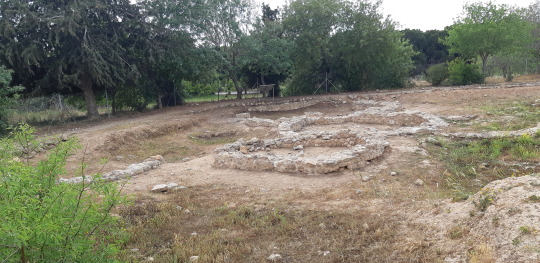




April 2024
Chalcolithic period round house remains, c3500BC-2400BC, Lemba village, Cyprus, with an archaeological reconstruction of the buildings.
1 note
·
View note
Text

Clowns research- Clowns began in the earliest of centuries, as early as 2400BC. However the clowns as we know today began in the 18th century, clowns performed in a rage of emotions from happy to sad in the early ages they was used as a jester like character. As time progressed the clowns roles varied and outfits changed to suit the times they were in. Clowns are now usually associated with the circus and being a usual over the top character to make audience laugh.
Harvard Reference: www.historyofthecircus.com. (2023). Clowning- Circus Clowns History and Facts. [online] Available at: http://www.historyofcircus.com/circus-facts/circus-clowns-history-and-facts/
0 notes
Text
alright i am going to begin with all of the (non-train related) history of the isle of sodor
6200BC- Sodor becomes a separate landmass from britain, ireland, and mann
4000BC- the first Indo-Europeans arrive on sodor, and they functionally eradicate all pre-indo-european culture and language on the island
3000BC- the sudric bronze age begins, as there is large amounts of tin deposits on the island, and many nearby copper reserves throughout britain
2400BC- (Alleged) first king of sodor, Ardcaggee becomes king of sodor and (supposedly), defeats seven dragons, six sea beasts, five giants, one giant dog with four heads, three medium-to-large sized rodents, two plant monsters, and someone else vying for the throne of sodor who might have also been a plant (the 2nd century poem that recites these events is unclear)
1600BC- First sudric dark age begins due to an alleged volcanic eruption, which supposedly bathes the island in dark clouds
1100BC- First sudric dark age ends and business continues as usual
950BC- the celts invade sodor and allegedly place Faildergdóit, legendary high king of ireland, on the sudric throne
720BC- first known historical king of ireland, Machan I becomes king, and dies four months later of a disease that most modern historians suspect to be naegleria fowleri, as the king believed that snorting water up your nose was a good way to preserve your reproductive health, and a week before he died, he said he was experiencing headaches, insomnia, and other similar symptoms.
720BC- King Machan II, also known as Machan the Bloody becomes king and he is a really shitty king so all the people rise up and kill him and all his known relatives and the house of Killdane ends at two members
177BC- the island of sodor is taken over by another clique, this time being a band of pirates allegedly from a land that was approximately 4000 miles west of sodor, which wouldn’t make sense because firstly 4000 miles west of sodor is inland and also it’s in the americas, and secondly, the pirates spoke a language that modern linguists believe is very similar to Ingrian, a Uralic language from around what is now Leningrad, so chances are they weren’t actually from the west at all
154BC- The oldest descendant of sodor’s modern royal family, Ulf I, becomes king of sodor
46AD- sodor and ireland have the same king for approximately two minutes until he decides that he doesn’t want to be in charge of ireland
123AD- king Feradach II and his army single-handedly defeat a roman army at what is now barrow, which pisses off the romans and they continually try and invade sodor, and the sudrians keep fending off the invasions until the romans leave britain
312AD- Christian missionaries try to convert sodor, and king Aedan VI of sodor goes down to Rennes and kills the king of brittany, puts his 2nd cousin Breesha on the throne, burns down every church, monastery, and cathedral in brittany, and makes a law saying that everybody in brittany has to be a celtic pagan from now on
420AD- Queen Breesha V becomes queen and she makes the country significantly more progressive
573AD- Sodor and ireland have the same king again and they continue to do so until 732
732AD- king Eochaid III resigns and sodor is left with an interregnum for 12 years
744AD- the king of sodor would have been the heir to the english throne had he not died before the king of england did
871AD- sodor becomes a vassal of england, who decides that Ulf XII would become king of sodor instead of Robert III, who was very clearly the legitimate heir
1066AD- Godred I becomes king of sodor and declares independence during the english succession crisis going on at the time
1324AD- grandson of saint machan of harwick becomes king of sodor, and everybody hates him but they also respect saint machan so one day, he “accidentally” falls out of a window, and dies.
1389AD- king Rolf II is a fucking idiot and gets the whole country taken over by england
1401AD- england loses control over sodor
1450AD- england gains control over sodor again
1471AD- england loses control over sodor again
1499AD- the king of england says that sodor would be “An independent nation for three hundred and fifty years, if not more”
1797AD- a revolution takes place, inspired by the french one, and everyone’s lives get better
1799AD- the first complete constitution of sodor is written, and it is very cool and good (for a country in 1799)
1854AD- the sudric monarchy is back again, and about time too, and they rewrite the constitution to suck a lot
1892AD- sodor is absorbed into the UK, and they still retain relative independence with their own constitution that is very good and cool and is continually modified so it can stay good
1946- railway series is published by the reverend w awdry
1984- a television series is created that’s based on the railway series
2021- a shitty reboot of the television series is created and the governor of sodor makes it illegal to watch within the country and publicly denounces mattel for being fucking stupid
0 notes
Link
#sumerian #Temple #Hymns & High Priestess Enheduanna, Kesh Liturgy to #Goddess SiN from UR (Syria). Following Humanity's fight 4 #enlightenment "Holy water & sacred word that is all you need said a gypsy witch with a snake around her neck" #sound #research
Thanks for your <3 Please Like! & Subscribe For more Updates and Videos Subscribe to us : https://www.youtube.com/user/Artof4elements
Follow Us In Other Social Sites:
Blog: https://www.artof4elements.com/ Instagram:https://www.instagram.com/artof4elements/ Twitter:https://twitter.com/AlchemyLoveNuit Fb: https://www.facebook.com/NatasaNuitPantovic Pinterest: https://www.pinterest.com/alchemyoflove
Wikihow Articles https://www.wikihow.com/User:Nuit

#ancient#language#babylon#First Script#first book#high priestess#Sin#Moon#neolithic shaman#kesh#temples#first temple#goddess worship#gods#greek gods#word of god#Ancient Egypt#shamans#amarna#2400bc#divine frequency#Sound#female wisdom#research#ama dios#God#goddess#divine#Natasa Pantovic#wisdom
5 notes
·
View notes
Note
Where do you think Gingerbread stands on religion? Because she has crosses everywhere on her design(most prominently her pupils), but neither her backstory nor the events she appears in ever explores that side of her. It also says that she uses both the forces of good and evil in her bio, but we never see what evil she uses either.
Gingerbread itself was used in religious practice in Egypt. By the time it was brought to Europe, people used molds to make saints and other religious figures out of it.
I would say Gingerbread herself doesn't get involved with religious practices but has her own beliefs. Her power probably draws from it but it isn't her main source. She's somewhere in the middle.
#food fantasy#ff gingerbread#don't listen to food fantasy#gingerbread was discovered in 2400bc#in greece
6 notes
·
View notes
Photo
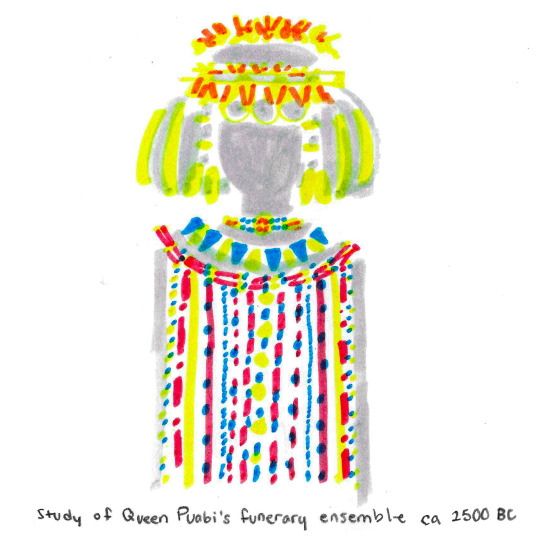
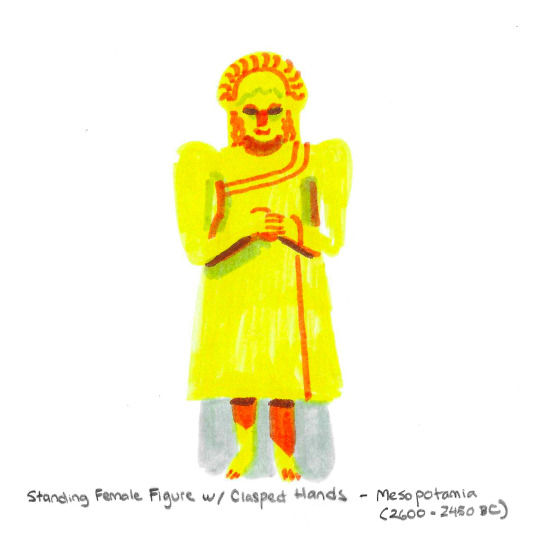
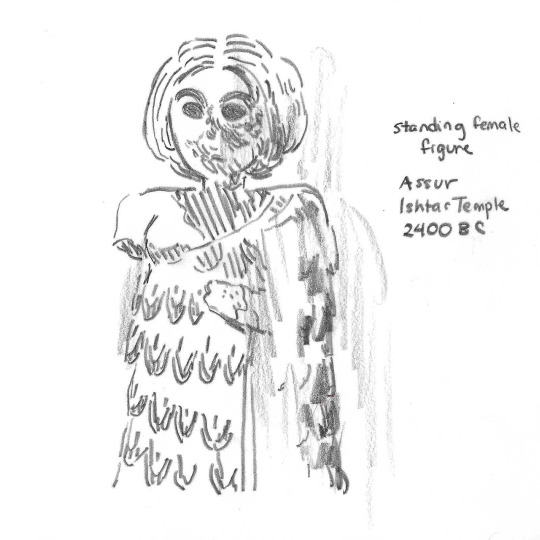
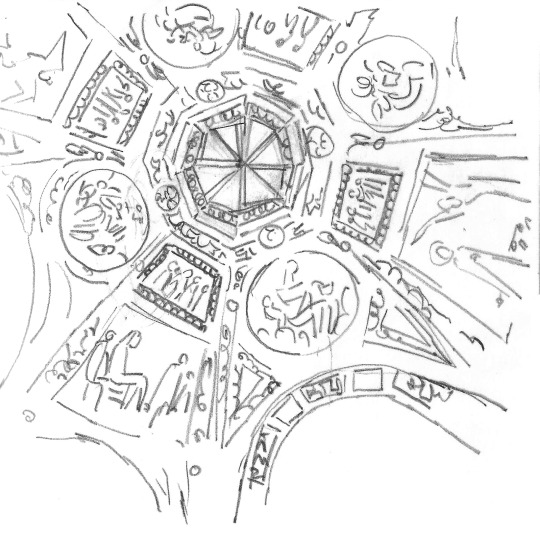
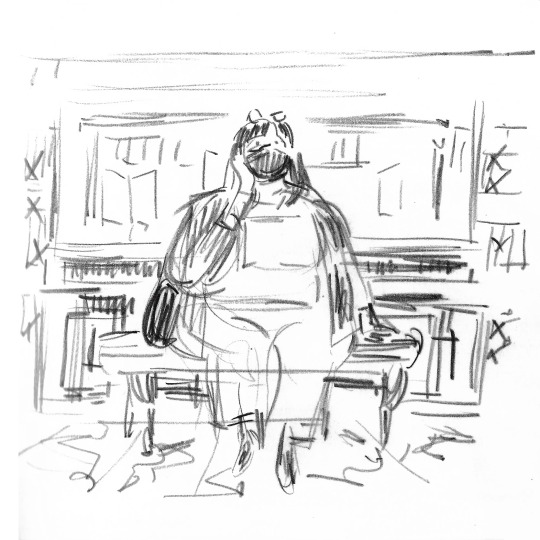

Sketches drawn at the Morgan Library. Image description under cut.
[ID: Six image photo set of sketchbook drawings drawn at the Morgan Library. 1) A gray mannequin bust wearing a golden floral headdress, gold hair coils and a series of necklaces with carnelian, lapis lazuli, and golden beaded chains hanging down the chest, drawn in marker. Written in pencil beneath the drawing, “Study of Queen Puabi’s funerary ensemble ca 2500BC.” 2) A stone carving of a female figure, drawn in yellow and orange marker, and shadows marked in gray. The figure is forward facing with her hands clasped at her abdomen. She wears a long-sleeved dress, hair braided around the top of her head, and bears a smile on her face. Written in pencil beneath the drawing, “Standing Female Figure w/ Clasped Hands - Mesopotamia (2600-2450 BC).” 3) Top half of stone female figure, drawn in pencil. The figure faces front-left three quarters, her right arm and left hand broken off. She bears a neutral expression, voluminous hair tied in a bob, and a woven dress with triangular etchings. The figure’s left side (the viewer’s right) is heavily worn down. Written on the right of the drawing, “Standing female figure Assur Temple 2400BC.” 4) Domed ceiling of the rotunda of the Morgan Library, sketched loosely in pencil. The center of the dome is an octagonal window, divided into eight triangular panes. Branching out from it are a series of repeating scribbled patterns, and mosaic panels featuring cherubs and other classical figures. 5) A casually dressed woman seated front-facing on a bench at the historic library room of the Morgan Library, sketched loosely in pencil. She has straight, medium-length hair, wearing sunglasses resting on her head, a face mask, open cardigan, t shirt, culottes, and closed-toe shoes. Her right hand rests on the side of her face, in the middle of a thought. Behind her is a glass case displaying books, and a wall of bookshelves. Beneath her is a carpeted floor marked by loose scribbles. 6) The fireplace of the Morgan Library historic library room, viewed at a right-facing, three quarter angle. It is drawn in pencil, spanning across one and a half sketchbook pages. The marble fireplace is carved with two Ionian columns to the sides, flanked by two, classical-style, bronze statuettes. Several birch logs fill the firebox. The back of the fireplace is decorated with a relief of a dragon resting atop flames.
End ID]
56 notes
·
View notes
Photo


A Cycladic Marble Female Figure,
Late Spedos Variety, Early Cycladic II, Circa 2500-2400 B.C.
11 3/8 in. (29.1 cm.) high
Christie’s
#art#sculpture#figure#marble#cyclades#cycladic#female#late spedos variety#2500BC#2400BC#archeology#collectors#Christie's
39 notes
·
View notes
Note
Can I have a fun fact about sheep
Since you asked so nicely, yes. Yes you can. Meet the fat tailed sheep




Absolutely ridiculous animals. So, technically the fat tailed sheep isn't actually a breed as much as it is a condition to be called, which is why they look extremely different. There's two different types of fat tailed sheep, the broad fat tail (left), and the long fat tail (right). Though broad is more common because the long actually grows fat on its tail until it hangs and hinders movement.
These guys have been around for a long time. Like, 2400BC and 3000BC Iraq on stone vessels and mosaics are the earliest records. It's even mentioned that fat tail sheep were sacrificed in the bible.
Okay, but why do they have that big ol behind? What's the point? Easiest answer, food. Humans selectively bread them because they liked the taste of the fat stored in the tail area. It was used extensively in medieval Arab and Persian recipes. Plus, since they're like camels, they're specially acclimated to desserts, so the fat comes in handy there too. But it was mostly food.
Look at these 17th century drawings of them. They make me chuckle.


#its funny i just learned about these guys a few months ago and i also learned that people didnt know sheep had tails#and also people thought camel humps had water in them#imma have to make a post about all the lies weve been told#anyway#feel free to send more animals!#don't mind me#answered#ask#primes22#sheep#animals#facts#my facts#fat tailed sheep
73 notes
·
View notes
Text

Jade bracelet, 2400BC-2000BC, Neolithic China.
81 notes
·
View notes
Text


Gold lunula from Blessington, Ireland
2400BC-2000BC
The British Museum
#ancient art#history#ancient#ancient history#ancient jewelry#art#bronze age ireland#ancient ireland#antiquity
161 notes
·
View notes
Photo





Corded Ware Culture
The corded ware culture developed somewhere around 3100BC but the exact location of its origins is still up for debate. The culture is named after the decorations on the pottery, which seems to have been applied with the use of cords. The culture itself lasted until around 2350BC and is important in the history of the Germanic tribes since it was this prehistoric culture that came into contact with the Proto-Indo Europeans.
The territory belonging to this culture was vast. It encompassed the later Germania, with the same borders to the west, the river Rhine, and large parts of eastern Europe, reaching all the way into modern day Russia. I do have to state here that even though the culture's territory was large, they were not an unified people. There are regional differences in their settlements and society. What combines them into one culture is their shared tradition of burial practices, tools and pottery decoration.
There is also of course the big question of: how and when did the Proto-Indo Europeans or Yamnaya culture influence the Corded ware culture? For a while it was actually presumed that the Corded ware people were the origins of the Proto-Indo European culture because they are very similar to the Yamnaya in terms of lifestyle and their tendecies for warfare. That theory has however lost most of its support nowadays. A more accepted theory is that the Corded Ware people spread the Indo European culture around Europe after they were invaded by the Yamnaya.
One other piece of evidence that suggests the Corded Ware culture were not the origins of the Yamnaya but were invaded later by them is the fact that it took until around 2400BC for the genetics of the Corded Ware people to change, only around that time period was 75% of their genetics similar to that of the Yamnaya people which suggests that the invasion came later than the formation of the Corded Ware culture.
What makes the Corded ware people an unique culture is their burial traditions. This culture buried their people in a single grave. No longer were people buried together in dolmens or barrows but each person now received their own single grave. The deceased was often buried together with objects such as battle-axes, pottery and jewelry. The males inside graves were positioned on their right side while females were positioned on their left side, there are exceptions to this, per example in parts of modern day Poland and Sweden it was exactly the other way around. The reason behind this positioning is unclear, it was perhaps part of their spiritual beliefs which have been lost in time.
The other unique element of this culture is its pottery. All the pottery belonging to this culture were decorated in a similar fashion with cord like patterns. These patterns were created by pressing cords or ropes into the wet clay until you had created a motif that you liked. Interestingly most of these defining pottery were found at burial sites so were these decorations reserved for burial gifts only?
Another important factor of this culture is not only the spread of the Indo European culture but also its language. Some historians have suggested that the Corded Ware people were the direct ancestors of the later Proto-Germanic, Celtic, Baltic and Slavic languages. This shift in language must have been implemented by the victorious Yamnaya which took centuries to spread across Europe.
One more last thing I want to mention about the Corded Ware culture is that they were also the ones responsible for the spread of horse riding around Europe and they were thé bronze age people who had the highest percentage of lactose tolerant people. These traits are thought to have been introduced by the Yamnaya people as well. Before the Yamnaya invasion, the use of horses was pretty much useless in western Europe, it was only after the invasion that the horse became a symbol of power and status. It is a possibility that the Corded Ware people can be seen as the ancestors of the later Celtic, Baltic, Slavic and Germanic people.
Here are pictures of: A map showing the territory of both the Corded Ware people and the Yamnaya. A map showing the theory of how the Yamnaya people spread their culture through Europe. Corded Ware pottery. Corded Ware axes. Corded Ware singe grave.
77 notes
·
View notes